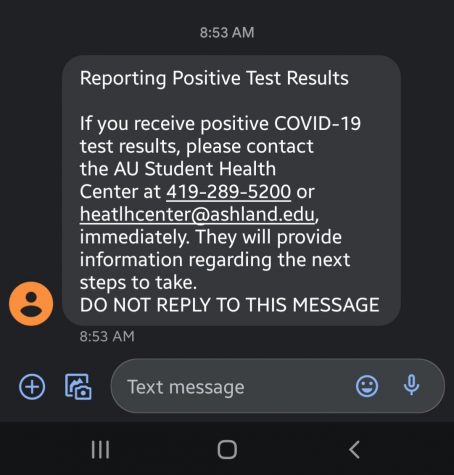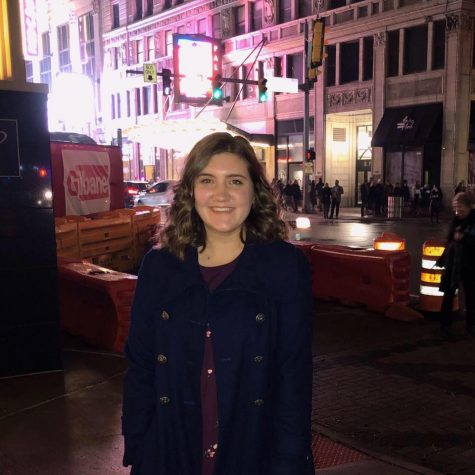Mass testing on campus proves success, mass text message does not
The Ohio National Guard administers the PCR test to AU students in Upper Convo on Jan 19.
February 5, 2021
1,077 students, staff and faculty found themselves subject to a mass-testing on Jan. 19, revealing that less than 2% of individuals brought COVID-19 to campus (for a total of 25 positive cases).
Ashland University’s COVID-19 Dashboard as of Feb. 2, showed zero new positive cases this week, with 11 active positive cases. Twenty-eight students were recorded to be in quarantine as well.
Those who participated in the testing day were welcomed into upper convo by an Ashland County Health Department official, who handed each individual two papers—one to fill out and hand to the nurse, and the other with details on how to find results of the test.
As everyone gathered the courage to get the tools used to swab, some were greeted by Ashland University’s COVID Response Coordinator, Elise Riggle.
“In terms of what AU did and could control, everything went better than imagined,” Riggle said. “The volunteers were amazing—specifically the student volunteers from the Rec Center. [Director of Recreational Services] Janel Molnar’s staff helped, without them it would not have gone as well.”
In the six hour testing window on Jan. 19, 1,077 students were able to show up.
One of the only complaints among the students was the length of the line. Traffic picked up in certain hours, resulting in a longer wait than the 20-minute window given to students in an email the previous week.
Some of the Ohio National Guard members who were meant to perform the tests were called back for inauguration purposes, limiting the testing stations available to students from six to four.
“We were still social-distancing and taking precautions, but at certain times in the day the line got longer. That was through no fault of anybody,” Riggle said.
Faculty, staff and many student athletes were pulled in to test earlier on Jan. 13, as well as anyone who was not able to make the testing day on the 19. In total, Riggle reported that 287 people were tested on that day.
Student athletes are exempt from testing if they are in active competition due to the frequent testing already being conducted on them. Those who are fully vaccinated or doing virtual learning are also exempt.
250 students reported a recent positive case and could not test.
“The idea of mass testing was to try to figure out, not only who the positive cases were, but to figure out how much our campus was going to be impacted by positive COVID cases,” Riggle said.
The mass testing results were accessible to students through the Mako Lab’s website (which could be found on the sheet of paper each student received the day of testing).
On the Thursday morning following the testing, students began to receive their results. Many logged on to view the lab’s official results; other students were misled by a text sent out by Resident Life, which read “Reporting Positive Test Results” as the subject line.

The rest of the text further explained what to do if the students received positive results, listing the Health Center’s phone number and email as further guidance.
This text resulted in hundreds of students calling in to the Health Center, reporting positive cases or trying to get approved for quarantine from being exposed to friends who they thought had a positive case.
In an emailed statement from the Health Center, the representative said, “The Student Health Center did not separate those calls out from other calls received that day. The calls that we did get from that text we tried to alleviate the confusion and assist individuals in how to get their actual test results. It was brought to our attention that the students were given a paper at mass testing on how to view their results.”
This caused a retraction to go out, informing students to only report positive cases that come from the Mako Lab.
“There is now going to be a vetting policy for texts, because that was a real learning experience. It was like waking up to fire,” Riggle said.
Eventually, this issue was smoothed over and students all received their results, reporting them to the Ashland County Health Department and the AU Health Center for next steps.
“The fact that we have just a handful of people who are maintaining this, all things considered, is impressive. I think AU is doing an amazing job of staying afloat,” Riggle said. “Ohio State [University] and other places have a lot of punitive actions for not showing up to testing, but we haven’t had to do that because everyone has been so gracious about showing up. People care more here, and that speaks to what being an Eagle is.”
Recently, Vice President for Student Affairs Dr. Robert Pool and Riggle, who work in tandem, helped introduce surveillance testing to the AU campus.
This idea of surveillance testing was proposed by Ohio Governor Mike DeWine. He encouraged universities to pull 3% of students each week for random testing.
The times range from 8:30 a.m. to 4:30 p.m. in Redwood and tests are being done by AU student nurses.
The PCR test which was conducted the first week of school was extensive. The upcoming surveillance testing is simplified and does not require the nasal swab to enter as far.
When sent the invitation, students must fill out an application verifying that they have no COVID symptoms; if they do, they are expected to call the Health Center. Surveillance testing is for asymptomatic people who are not currently positive or have had a recent positive.
“If students didn’t show up, then they will be among those who are selected for the surveillance testing,” Pool said. “Generally that’s random, but we’ll always try to pull those who didn’t test. It’s our way of keeping in-check any community spread.”
30 to 50 random students will be selected every week for a test.
“We have both received from the state and have purchased rapid antigen tests, [which] don’t go quite as far up the nasal cavity. They’re administered by one of our nurse practitioners, and within 30 minutes we know the results.”
There are no plans of doing another baseline test.
“I thought we did really well with the number of students who showed up—that’s a really good baseline for our population. We needed an overwhelming number of students to participate and that’s what happened.”
So far the prevention methods have proven to be effective, Pool said.
With mask-wearing, social-distancing, symptom-checking and reporting symptoms, AU has kept a low spread rate.
“It doesn’t mean we won’t see more infections, we certainly will, it just means we try to keep the percent of spread and the speed of that spread low,” Pool said. “We don’t have any evidence that the virus is spreading in classrooms. We saw going back to classes as a very low risk and we didn’t want to delay going back to classes because of the testing.”
The mandate of organizations needing to hold virtual events was relaxed, Pool said. This allows students to hold more face to face programs. The new policy requires students to maintain a social distance, wear masks and monitor students on whether they are showing symptoms.
To stay up to date on COVID results, ashland.edu/covid-19-dashboard.



